What Do You Know About South Korea...?
The area of South Korea is 99,300 square. Km, which is 9% less than its northern neighbors, seems to bargain most of the Korean Peninsula through the support of the Soviet Union, who hopes for the victory of communism in Asia and shows an advantage over capitalism.
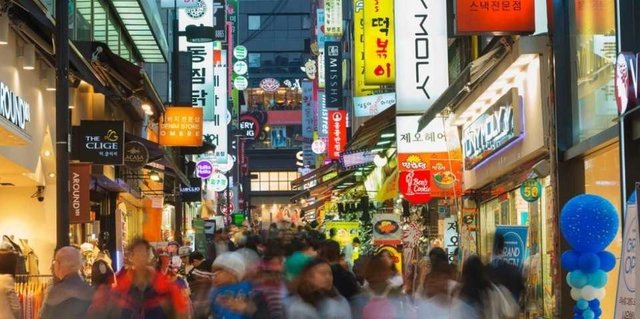
The population exceeds 51 million people, the density - 525 people per square. km. In Seoul, the nation's capital, there are 10.5 million people. or every fifth Korean. The IQ of very tall people, is 1.06, the poet is a natural result when setting aside the ideological prejudices imposed by politicians, South Korea has achieved success in the economy, which does not dream of their northern brethren.
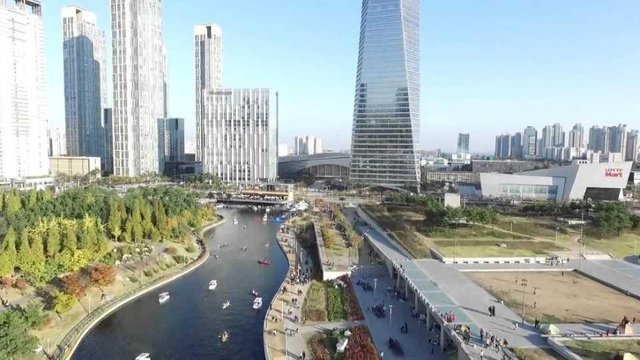
the natural and climatic conditions of South Korea in the north near the 38th parallel that divides North and South Korea are virtually identical: January snow does not exceed 3-5 degrees below zero with the possibility of low temperatures on several days to 15-20 degrees, and temperature in July is within 23-25 degrees with a gradual warmup in the southern coast of the peninsula, washed by the waters of the Korean Strait.
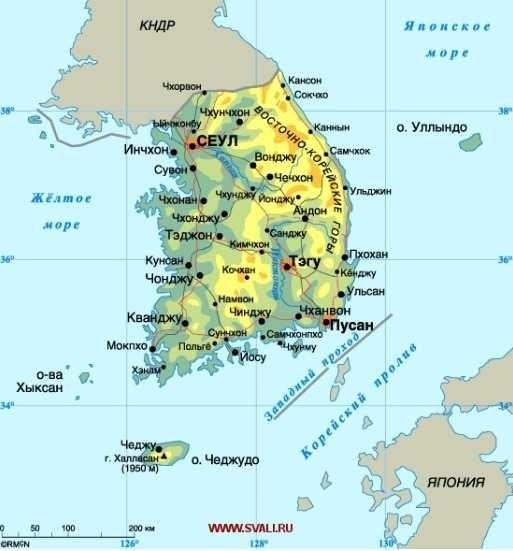
The territory of the country in the west was washed by the Yellow Sea, and in the east by the Sea of Japan. In the vicinity of the peninsula there are more than 3,500 islands, mainly on the western and southern sides, the largest of which - Jeju, covering an area of 1825 km 2 or almost 2% of the whole country. The amount of rainfall in July-August reaches 60% of the total annual rate, ie 1000 mm / year, although sometimes only 70-750 mm falls in the dry years, which in that period causes the decline of crops to critical levels (in North Korea this causes hunger). In summer, an average of three typhoons, causing floods, occurs.
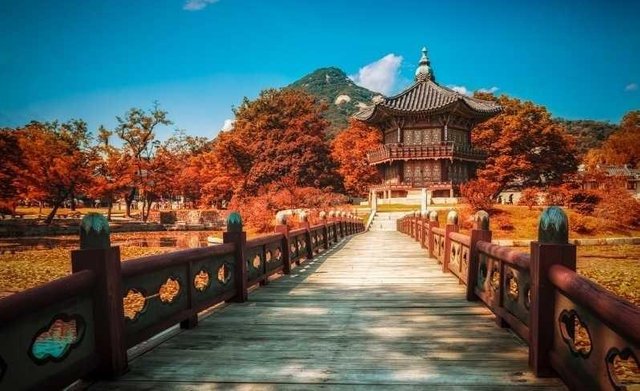
Minerals in the country are the same as in neighboring North Korea: coal, iron ore, manganese, tin, zinc, nickel, tungsten, molybdenum, thorium, graphite, talc, limestone, kaolin, gold and silver in small fields. Flora and fauna are rich and diverse forests and seas used in economic life to harvest timber, bamboo, fisheries and other destinations.
The forest occupies 65% of the land area, fertile land - 21%, grassland - 1%. South Korea for the past 55 years (since 1973) from a poor country with revenues of about $ 160 per capita per year has turned into the most advanced country and has taken a leading position in the world with per capita income of more than $ 28,000 (nominal progress 170 times ), which is a kind of economic development record among all countries in the world. Gross domestic product in 2017 totaled $ 1.54 trillion, bringing the country to 11th place in the world, and economic structure (agriculture - 2%, industry - 39%, service sector - 59%) reflects the country's orientation towards production high-tech products, intended for export. Levels in economic development are not made on natural resources but on the intellectual potential of the workforce and, like the results achieved,
It is only North Korea that has not moved from traditional communist doctrine to build a society without rich people, who condemn the population to the eternal poverty most needed for normal life. And how can you achieve a decent level of wellbeing with a country's GDP of less than $ 40 billion? And South Korea, with $ 1.538 billion, can certainly improve welfare to an unprecedented level, despite having 15% of the poor, but the poor do not like Kim Jong-un's poor regime.
South Korea's economy became a post-industrialized economy in which the economy became an informative character, as evidenced by shipments to the export of high-tech products worth $ 133 billion, accounting for nearly 10% of total GDP generated by 2014. Korea occupies the leading position in terms of the number of Internet users, the role of sulfur services with the help of information technology is increasing.
In the service sector received in 2015 gross revenue of $ 814 billion. Industrial production is represented by industries such as aerospace, shipyards (specializing in container ships and tankers), electronics (television, computers and components), manufacturing of information systems, optical instruments, electronic equipment and others that determine the progress of science and technology.
On the new technical base, the traditional industry is expanding: iron, automotive, petrochemical, metallurgy, machine construction, light, food, textile. chemical industry. In shipbuilding, the country occupies the third place in the world (after China and Japan), 35% of ships or any third vessel built in South Korean shipyards.
Agriculture is also growing with a view to the world's agrotechnical science using high technology, which makes it possible to fully meet the country's need for food. Production of paddy, the main food crop, is 4,330,000 tons in 2015. large areas are occupied by plants such as potatoes, Chinese cabbage, radishes, red pepper, vegetables and fruits (apples, pears, tangerines.) Livestock specializes in poultry (ducks 16 million chickens, 164 million chickens), pigs and large livestock, but pork and beef in large quantities purchased with imports, according to the level of agricultural development of the country is ranked 5th in the world after the United States, Japan, the EU and Canada.it's suitable for agricultural land only accounted for 20 thous km 2. On innovation in the field agriculture, the country is ranked 4th in the world (88.5% of US level).
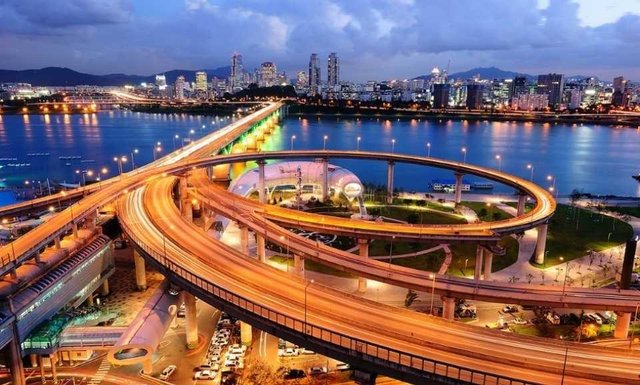
Export products ranked 8th in world results from global torgovlisostavili $ 714 billion that more than half of GDP for 2014. Flourish all kinds of transportation in the country and to maintain operatsiy.Apriori import-export can say that the development of transportation depends on Damage to economic development. The striking success of South Korea is due to investments in education and science. Science in 2014 uses 4.3% of GDP, which is more than US, Japan or EU developed countries, which invest from 2.5 to 4%. Another factor is the use of working time most of the year, when leave is given only 4-5 days a year, but it is required initially, until the country has accumulated capital, allowing then to make a breakthrough in the competition for the market.
Perhaps, we should also use the experience of Koreans who deserve all the rewards for their hard work and examples of how to achieve economic progress in post-industrial society.
Congratulations! This post has been upvoted from the communal account, @minnowsupport, by badribireuen from the Minnow Support Project. It's a witness project run by aggroed, ausbitbank, teamsteem, theprophet0, someguy123, neoxian, followbtcnews, and netuoso. The goal is to help Steemit grow by supporting Minnows. Please find us at the Peace, Abundance, and Liberty Network (PALnet) Discord Channel. It's a completely public and open space to all members of the Steemit community who voluntarily choose to be there.
If you would like to delegate to the Minnow Support Project you can do so by clicking on the following links: 50SP, 100SP, 250SP, 500SP, 1000SP, 5000SP.
Be sure to leave at least 50SP undelegated on your account.
Very informative. Have you been traveling to south korea?
Congratulations @badribireuen! You have received a personal award!
Click on the badge to view your Board of Honor.
Do not miss the last post from @steemitboard:
SteemitBoard World Cup Contest - The results, the winners and the prizes
@badribireuen you were flagged by a worthless gang of trolls, so, I gave you an upvote to counteract it! Enjoy!!